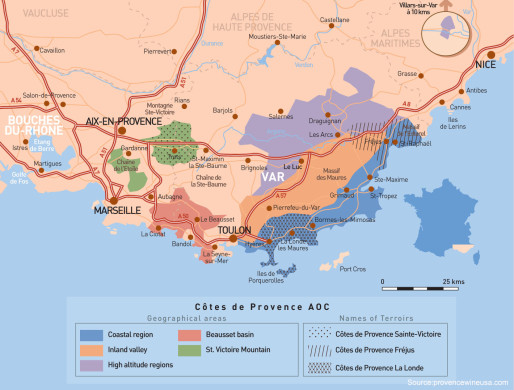Provence, France always brings a smile to people’s faces. Provence is home to the cities of Aix en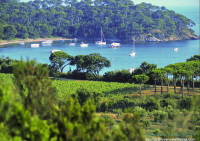 Provence, Arles,Cannes, Marseilles, Nice and Sain Tropez.The wines, the weather and the beauty of its natural landscapes make this a delicious dreamy package. While many of us can not be there we still can partially realize the beauty in our own backyard. No matter what time of the year, all we need to do is drink a bottle of wine from Provence. Rosé, red or white, they all work the same magic.You feel relaxed and sunny blues skies can appear.
Provence, Arles,Cannes, Marseilles, Nice and Sain Tropez.The wines, the weather and the beauty of its natural landscapes make this a delicious dreamy package. While many of us can not be there we still can partially realize the beauty in our own backyard. No matter what time of the year, all we need to do is drink a bottle of wine from Provence. Rosé, red or white, they all work the same magic.You feel relaxed and sunny blues skies can appear.
Introduction
Below we will learn about the Provence wine region. We will cover production standards, the appellations and sub appellations, climate,soils and the grape varieties grown. This essential background information will hep you better understand the wine in your glass. There is also a link at the bottom to some critical wine reviews of Wines from Provence.
Wine Production Standards
Provence is an official French wine producing region and therefore it is recognized to be an Appellation d’Origine Contrôlée (AOC). AOC wines rank above wines labeled Vin de Pays and Vin de Table. Provence is also a member of the European Union’s wide system of quality control regarding production standards. This system is known as Appellation d’Origine Protégée (AOP). The AOP considers each wine by their place of origin and then sets production quality standards. Some of the quality standards govern allowable grape varieties for that region and the maximum yield per hectare.
Climate
Provence is located in South East France with the Mediterranean Sea forming its southern border. The climate is classified as Mediterranean. There are mild winters followed by heavy rains in the spring. The summers are very warm and dry followed by rainy fall seasons.
Provence also experiences the strong mistral winds that blow from the north. The winds benefit the vines by cooling the grapes and drying the grapes after a rain. Unfortunately the winds can be strong enough to shake the grape vines and cause broken vines and fallen grapes. To reduce the negative effects of the winds, the vineyards are planted on the south facing slopes. These slopes have less wind but have greater exposure to the warm sun.
Location
Provence is located in South East France at the latitude of 43 degrees. Provence is comprised of eight AOC wine regions/appellations, with three of the appellations producing 96% of the wines.
The three major appellations are:
1) Côtes de Provence AOC
2) Coteaux d’Aix-en-Provence AOC
3) Coteaux Varois en Provence AOC
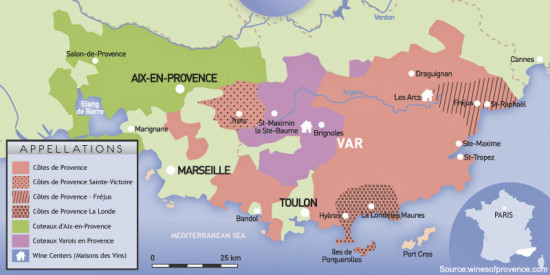
Provence Wine Appellation Map
Côtes de Provence AOC is the largest appellation with its four sub appellations of
1) Côtes de Provence Sainte Victoire AOC
2) Côtes de Provence Frejus AOC
3) Côtes de Provence La Londe AOC
4) Côtes de Provence Pierrefeu AOC
Côtes de Provence AOC
From here approximately 73% of all wines of Provence are produced with 88% being Rosé, 8% Red and 4% White wines. Quality is always important in Provence. The quality control standards of the AOP permit an authorized yield of 55hl/ hectare but the actual average yield is 49hl/hectare.
Soils
There are five major geographical regions of the Côte de Provence as noted on the map.
- Costal Region: This is the crystalline coastal region of Les Maures. From the erosion of the rocks form the Les Maures mountain range, the soils are sandy clay with quartz rocks having a color range of brownish yellow to reddish brown.
- Inland Valley: The vineyards that are located on the hill side slopes and those located at the top of the Valleys have sandy loam clay. There is crystalline rock or limestone in the vineyards on the northern and southern edges of the hill side slopes.
- High altitude regions: The majority of the vineyards in the AOC are located in this geographical region on the plateaus, slopes and higher elevation terraces. The soil is rocky with limestone and reddish brown sandy clay.
- Beausset Basin: The land is layered with calcareo-marl and limestone. The vineyards are located on the slopes and the tops of the valley in shallow soils.
- Sainte-Victoire Mountain: The vineyards are planted on reddish pink colored soils that are sandy clay with high limestone content.
Sub appellations:
Sainte-Victoire: The climate is a blend of Mediterranean and Continental with the Aurelien and Sainte Baume Mountains protecting the vineyards from the effects of the sea. The nutrient poor shallow soils consist of limestone and sandstone. Wine production is 90% Rose and 10% Red.
Frejvs: This sub appellation’s proximity to the sea offers constant breezes on the vineyards. The region also receives the most rainfall. Here we can find soils that are red rocky sandy clay with loam. Wine production is 90% Rose and 10% Red
La Londe: This sub appellation has its own climate due to the nearby Mediterranean Sea. There are mild winter and summer seasons and the annual rain fall is low. The vines are planted along the coast southeast of the Maures mountain range in a variety of soils. The soils here are:
shale, shallow and rocky or,
loose sediments with shale and cobblestones or,
loose sediments with quartzite, sandstone and shale or,
old silt, clay, sand, quartzite sandstone and shale pebbles.
Wine production is 79% Rose and 21% Red.
Pierrefeu: This is new sub appellation and is not yet shown on the map. 2013 will be the first vintage under this new sub appellation.This area is in the center of Provence with a mix of Mediterranean and Continental climates.Three types of soils are found here:
red sandy clay that is rich in iron
limestone gravel with red sandy clay
brown red silty clay covered with slate gravel
Coteaux d’Aix-en-Provence AOC
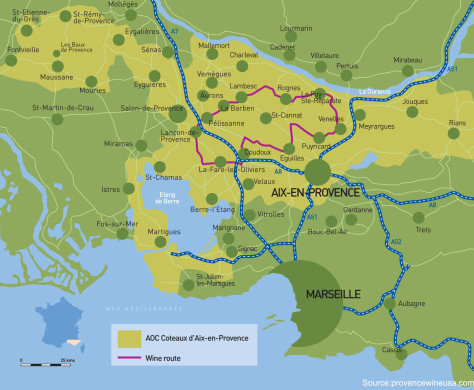
Coteaux d Aix en Provence Appellation Map
The Coteaux d’Aix-en-Provence AOC is located in the western area and is the second largest appellation in Provence. The vineyards are mainly located in a sedimentary basin area as noted in red on the map. Here the soil is limestone and clay. The climate is Mediterranean with the Mistral winds.
The quality control standards of the AOP permits authorized yield of 60hl/ hectare and the actual average yield is 47.5hl/hectare. Wine production is 81% Rose, 15% Red and 4% White
Coteaux Varois en Provence AOC
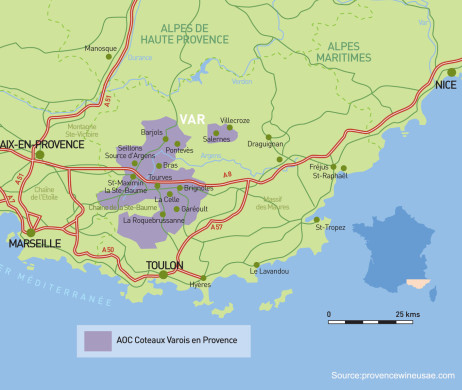
Coteaux Varois Provence Appellation Map
Coteaux Varois en Provence AOC is located at the center of Provence. The climate is more Continental as a result of the vineyards being at higher altitudes of about 1,000 feet above sea level. The vineyards are also surrounded by mountains and are not subject to the influences of the sea. The winters are harsh followed by mild springs. Hot, dry summers are followed by mild falls.The soils are clay and limestone and some gravel.
The quality control standards of the AOP permits authorized yield of 55hl/ hectare and the actual average yield is 46hl/hectare. Wine production is 88% Rose and 9% Red and 3% White.
Grape Varieties Grown in Provence
Red Varietals
Carignan
Cinsault
Grenache
Mourvedre
Syrah
Tibouren
Cabernet Sauvignon
White Varietals
Bourboulence Blanc( Doillon)
Clairette
Grenache Blanc
Rolle
Sauvignon Blanc
Semillon
Ugni Blanc
Below area few critical wine reviews of Provence wines. See the French Wine Review tab for more reviews.
